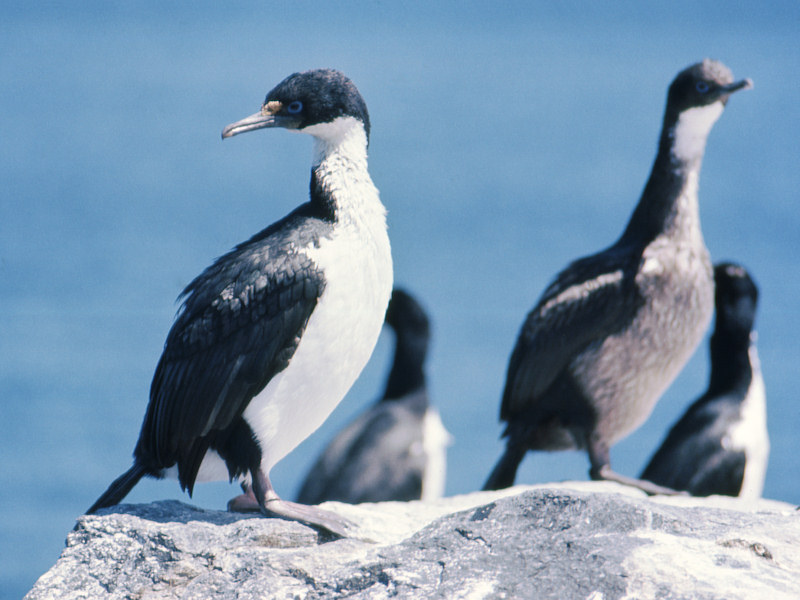Photo
album: "In the neighbourhood of the base"
Fly
over a photo with the mouse to enlarge it
Click
on a photo to open it in a new window
A
Sunday afternoon, taking advantage of the fine weather, we take a few-hour rest
and go to explore the neighbourhood of Port-aux-Français base.
 |
Mount Ross, altitude 1850 m, this
summit has been inviolate for a long time. It will be conquered, by a
French alpinist team, only in January 1975. A south African team will be
forced to give up a second attempt, a few weeks later, because of the bad
weather. Though the altitude of this peak seems moderate, the conditions
there are very difficult because of the ice-covered unstable rock. The ice
begins nearly at sea level and the weather conditions change very quickly
with violent winds and precipitation. |
 |
Lichen-covered rocks.
|
 |
Floating stripes of giant kelps (Durvillea)
which abound along the cost. |
 |
On these rocks, a group of
Kerguelen cormorants. |
 |
Cormorants eat only fishes. Their
plumage partially permeable lets the water go through and allows them to
spend less energy when they dive because they wet themselves quicker than
the other birds. The plumage of the other birds, generally impermeable,
keeps some air imprisoned and tends to make them float. |
 |
A characteristic of Kerguelen
cormorants, in addition to their white belly, is their blue eyes. |
 |
We meet four king penguins, they
are second in height, to the emperor penguins. They are 85 to 95
centimetres high and weigh 8 to 16 kilograms. The lonesome penguin, at
left of the photo, is a gentoo penguin. These penguins are 50 to 70 cm
high and weigh 5 to 7 kg. On the beach, we can see accumulation of
fragments of kelps brought by the sea. |
 |
Another group of king penguins. |
 |
Two king penguins in the middle of
acaena, Kerguelen main vegetation. |
 |
A Kerguelen tern. |
 |
Take off of the tern. |
 |
The yellow flowers in the middle
of the acaena carpet, on the bank of the brook, are not of Kerguelen
origin: they are dandelion flowers, accidentally imported, they can be
seen in different places around Port-aux-Français base. |
 |
Pierre Bouvet, a friend from Groupe
de Recherche Ionosphérique, shoots a close-up on acaena. |
 |
I hurry up to imitate him. |
 |
Acaena hold back the sandy soil and
keep it from being carried away by the elements (wind and rain). Thus,
there are formation of tufts rising over barren zones. |
 |
Taking off of a sub-Antarctic skua.
These birds differ from their Antarctic homologues by their darker
plumage. |
 |
A young elephant seal is watching
us. |
 |
A rabbit runs away in front of a
group of elephant seals. Rabbits were introduced many years ago to give
food to possible future shipwrecked men. They have multiplied and have
invaded nearly the whole archipelago, destroying most of the original
vegetation. |
 |
I am watching a group of elephant seals, in phase of moult: They are
bathing in the mud to soothe the itching caused by this change of skin. |
 |
Maybe this young elephant seal will
have some difficulties to get out of its bath of mud! |
 |
On background, behind me, the first
grey building is a former factory, built by the Société industrielle des
abattoirs parisiens (SIDAP) [industrial society of Parisian
slaughterhouses] in 1955-1957. This society hunted the elephant seals
and boiled them to extract oil. This plant was closed in 1960. |
Go
back
.
.
.
.
.
.
.















